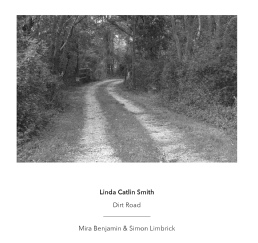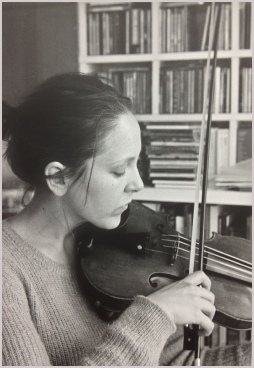Another Timbre TimHarrisonbre

at97 Linda Catlin Smith - ‘Dirt Road’
A composition in 15 movements for violin and percussion
Played by Mira Benjamin (violin) & Simon Limbrick (percussion)
Total Time: 68:33
Interview with Linda Catlin Smith
There are very few hour-long duos for violin and percussion; it's an unusual combination. Why did you choose those instruments? And did you always intend to compose such a long piece, or did it evolve in the process of composition?
Dirt Road started off as a commission from a choreographer for an hour-long work. I chose violin and percussion because I thought it was one of the most challenging combinations I could think of. It was also practical – I live with a percussionist (Rick Sacks) so I knew I had a willing performer for a longer work. But I was interested in the idea of putting two very unlike instruments together to see what I could do.
The piece ended up not being used for dance – by the time I had recorded the piece, the choreographer felt that her choreography needed to occur in silence – a decision I understood when I saw the work. So the piece ended up as a concert piece, and it has been performed several times. The length was something I was very interested in at that time – I had written several longish works in the years prior to Dirt Road, and just the year before I had written a 45 minute work for cello and piano (Ballad) which is also released on disc (World Editions). I wanted to feel I could take up space in a concert, rather than appearing (often) as the slow movement between faster and louder pieces on a varied program. This way, I could create a world for an evening that was all to itself, not juxtaposed with other worlds.
It’s interesting that it was originally conceived as a dance piece, because I always feel that some of the movements have a balletic quality.
I wasn't aware of it, but it makes sense. As the piece was for dance originally, I must have wanted to give some moments that invited a certain kind of physical energy or movement…
Why the title Dirt Road? Does it refer to anything in particular?
I called the work Dirt Road because I felt I was working with material that was plain, simple, unadorned. It also implies, for me, the sense of being a bit off the beaten path. I like the image of solitude that it invokes, and the sense that there is not a lot happening. And yet when you walk in the country on a lonely path, there is always so much to see and to think and to feel.
I also think that parts of the pieces sound like folk music from a world that is related to ours but at one step removed. Do you listen to folk music at all?
I listened to a lot of folk music in my earlier life. When I was a teenager I was playing Irish and Appalachian folk music (on flute mostly) and I often went on Monday nights to the Irish Arts Centre where the best folk musicians in NY were playing late into the night. I was dancing a lot in English Country Dance groups in NY and I was a dancer in an ensemble devoted to 18th century dance. I love the lightness and transparency of that music and the slight looseness of the playing together. I also listened to a lot of Baroque music (I built a harpsichord from a kit when I was in high school, and I played harpsichord at university) and the texture and nuance of that music is a big part of me.
Could you say a bit more about your musical formation and how you came to experimental music?
I don't know if I think about whether music – any music - is experimental or not – I am more or less waiting to be surprised or put in a state of wonder. In my own work, the experiment is always about whether something will hold – usually I ask myself questions – can it be longer, can it repeat, can it have silence, can I put this in another register, can I make the harmony more ambiguous, can I add another layer…how thin or thick can it be, how dense or sparse? Are there sections or movements or is it somehow all one thing? Is it anything? Can I loosen it in some way? Can I get lost in it?
As for my musical formation, we had a piano at home, and I had piano lessons from a young age – before I could read. I was very lucky to have a composition teacher in high school – Allen Shawn – who gave me records to listen to, and showed me scores, and took my music seriously. At home we had lots of recordings – classical and jazz – and I listened to them all the time. I listened to music as I fell asleep – I was allowed one side of a record every night. I was so curious about music – I always wanted to hear something new. But at the piano, I would play the same chords over and over again, just to surround myself with a certain sonority. I still do that when I'm composing – to make sure the sound is what I want, to make sure it is somehow right.
That ability of music to surprise is certainly evident in Dirt Road, which turns and meanders in lots of unexpected ways. The 15 movements are numbered, but can be played in any order, so I suppose that putting the CD in random play mode would work well for the piece – or do you like to hear it in numerical order?
For me, the reason to write different movements is to have the chance to explore contrasting material and ideas. This allows for a kind of detour – taking a side road off the main road perhaps. Each movement is its own small world. I have made the order of movements flexible so performers can feel they can use as many or as few movements as they would like. I am open to alternative orders of movements, and of course when you change the order, the overall experience will have a slightly different sense of unfolding. This order felt right to me, but I can imagine the piece could work in all kinds of ways – one can always take a different route home…
Like many of your pieces, Dirt Road combines an intimate delicacy with a physicality that is probably only fully apparent in performance. Are those qualities that you consciously seek out, or do they just happen to recur in your music?
I am very drawn to the intimacy of music - I am aware of the feeling of sound almost as it goes in my ears. This aspect of 'touch' - the violin bow on the string, the lip on the mouthpiece, the finger on the keyboard - is what draws me to certain musicians; there is a quality of control and intimacy with sound that they bring to their instrument that has to do with imagination, with listening, and with a certain physicality - touch - in relation to sound. I like to compose music that invites these delicate, intimate qualities. I would say it is always in the background of my thinking.

Linda Catlin Smith
Mira Benjamin,
Photo: Anton Lukoszevieze

Reviews
“Linda Catlin Smith, a native New Yorker long resident in Toronto, writes music that is gentle, gradual and generally austere. On the cover of her latest release is a photograph of a dirt road, taken by Smith herself. A simple two-lane track, etched into the earth through repeated use and wheel-friction stretches to a bend, then disappears behind trees.
The music, a sequence of 15 episodes ranging in length from two and a half minutes to ten, has a lonesome kind of beauty. The contrasting instrumental voices of percussionist Simon Limbrick and violinist Mira Benjamin become subtly complementary as they meet on a shared path of frail continuities and slow metallic pulsing, wistful melodies and dull, trundling thuds.
Smith is a sharp observer of what William Carlos Williams identified as “imaginative qualities of actual things”. When physical realities are addressed in her music they are invariably filtered through memory or anticipation, yearning or daydreams. On her previous CD, indicitavely entitled ‘Thought and Desire’, Smith’s setting of a Shakespeare sonnet is performed with real sensitivity by pianist Eve Egoyan. That music artfully matches the poem’s portrayal of two bodies caught within a web of supposition, as anxiety and consolation fluctuate within a love affair.
The title ‘Dirt Road’ might seem to call for music that is far more matter of fact, roughly textured and minimally linear, but its episodic structure and mobile alignments of violin and percussion actually suggest elusive states of mind rather than locatable stages on a familiar journey.
Smith is again involved with perceptions that are as volatile as the play of light, as ephemeral as a momentary distraction or fleeting recollection. Ambivalence resonates through the fabric of her music, making it haunting and special.”
Julian Cowley, The Wire
“Linda Catlin Smith's Dirt Road is one of those works in whose world you want to live. Music of cold, clear beauty.” Alex Ross
“This is a magical piece and recording, very likely the thing I've played the most this year so far.”
Michael Pisaro
“Dirt Road started its life as dance music. Commissioned by a choreographer, this near 70 minute piece for violin and a glowing array of percussion (including vibraphone, gongs, cymbals and triangles) by the Canadian composer Linda Catlin Smith achieves ambitious and euphoric heights through a startling shy set of musical materials. As the title suggests, the music wanders, meanders, floats through a sparse landscape of gentle melodies, hushed drones and distant chimes. In the end, the choreographer who commissioned the piece decided that their dance was better accompanied by silence. At times Dirt Road treads a path so close to this, in such a poised and balletic fashion, that silence seems like the next logical step.
Smith’s music encapsulates the beautiful paradox within all economic music: by stripping back the music to its pure essentials, one’s listening experience is totally heightened, resulting in an awareness of the sounds and a receptiveness to them which is if anything maximal rather than minimal. From the outset of Dirt Road, one is aware of the incredible depth to each of the sounds as they’re isolated in time. Each sustained note from Mira Benjamin’s violin in ‘Track 01’ presents a myriad of layers, allowing you to submerge yourself and focus your ears as you like to the rich overtones, harmonics and grain that emerges as the piece goes on, like stars revealing themselves as you stare into the sky.
Through its long duration, this magnetic attention to every sonic moment as they pass results in a sense of getting lost within the architecture of the piece. Structurally, Dirt Road consists of 15 movements which can be arranged in any order from performance to performance, or on a CD can simply be played on shuffle. Within this framework it’s your memory that writes the piece as it unfolds. Chords, melodies, textures seem to reoccur, but often accompanied by a question mark: Is this music repeated? Is my imagination toying with me? Despite this, some moments feel gloriously culminatory and provide key arrival and pivot points along the way. Moments like the incredible high violin and vibraphone unison that begins ‘Track 04’ and the rolling cymbals and drums that open ‘Track 09’ are so striking that they seem to offer a sense of perspective onto the music, as if they are what lies at the end of a particular avenue that lies off the main sonic path which is Dirt Road.
Smith has described her compositional process as being one defined by questions: “Can it be longer? Can it repeat? Can it have silence?” Whilst listening to Dirt Road, you may wonder to yourself whether some sections could have been shortened, especially as some of the most enjoyable moments seem the most fleeting, such as the rustling textures in ‘Track 11’ and ‘Track 14’. Even though it is quiet in dynamic and soft in touch, this is clearly a piece of extremes. Smith said she chose the pairing of violin and percussion because it was the “most challenging combination” she could think of, and this sense of challenge for both the composer and the listener underpins Dirt Road in its length, its economy and its stamina of restraint. But this challenge is a valuable one. To be engulfed by not only the music of Dirt Road, but also by the focused 68-minute long listening ritual that accompanies it is truly special, providing an increasingly rare and important chance to just sit and listen.”
Jack Sheen, Truants
“First, I have to say that I had Linda Catlin Smith all wrong. She seemed to be a composer a little bit outside the usual sound-world of Another Timbre. What little I’d heard of her music up until now showed influences of folk music, particularly of traditions from North America. Based on that, I’d lazily pigeonholed her with the current generation of American composers who have found commercial success through exploiting a ‘vernacular’ of a steady pulse and conventional harmony. This was unfair of me. Dirt Road, a lengthy set of 15 movements for violin and percussion, was written 10 years ago but is making a wider impression only now.
The title itself suggested an appeal to folksy authenticity that has been fashionable lately, in music as much as anywhere, and has already started to grate as much as the lumberjack shirt on an artisanal barista. Listening to the disc with that mindset becomes an astonishing revelation. The first movement is minimal, a violin drone supplemented with bass drum and occasional flourishes of vibraphone. The second suggests a folk influence, modal patterns to slow and brief to be considered full melodies. The pairing of instruments is peculiar, violin with percussionist, often on mallet instruments with occasional drum or cymbal. The first time I listened, the music went from pleasant, to strange, to captivating – it’s beautiful in a way that the listener can never settle into and take for granted.
Each new movement opens up a new perspective on the whole, returning to ideas heard before and presenting them in a new way, introducing a twist, opening up a new set of sounds that casts different light on what was heard before. Some movements can be quietly lyrical, others severely minimal, yet the work holds together as a unified experience, more than the sum of its parts. There’s a complexity of musical thinking going on here, belied by the simplicity of technique.
Violinist Mira Benjamin and percussionist Simon Limbrick play with a richly detailed grain to their sound, with edges just rough enough to give predominance to the physical sounds of the instruments that are so important to making the music work. Each moves effortlessly between foreground and background when needed. This CD has deservedly been getting a lot of attention. As Tim Rutherford-Johnson writes, “Smith’s time has, finally, come.”
Ben Harper, Boring Like a Drill
‘When it comes to modern music, there is an audience that often wonders: “Where’s the melody?” A lazy ear often fails to discern it but it is there. Chances are that the audience was looking elsewhere. Today’s composer also holds the three traditionally held principal constituents of music together in his or her unique style, which, if one listened with an open ear, would reveal a world of wonderfully coherent sound. Linda Catlin Smith’s celebrated new release, Dirt Road, is one such piece of music in which melody, harmony and the rhythm of the earth, together with passion and precision, coalesce and balance ideally. What magic and mystery she achieves in a work full of knowingness, warmth and beauty, violinist Mira Benjamin and percussionist Simon Limbrick always seem to find a direct and unimpeded path to this musical truth and eloquence. You will not hear a more fervent and inspired interpretation of this suite of 15 miniatures, played with mastery of ever-changing colour, light and shade. Every nuanced aural entity is given time to breathe and speak, to weep, sing and sigh just as Smith envisioned in her work. Immaculate virtuosity is always pressed into service, but never at the expense of emotion and passion. The endlessly mercurial and fascinating pieces reveal the composer’s patrician eloquence and refinement. And you never have to strain to hear the melody; Smith doesn’t even try to hide it under a bushel along this proverbial road less travelled. The purity of sound with which this performance has been captured has been repeated in all four Another Timbre recordings. But more than anything else it is the beguiling melodies and other sonic surprises that inform these releases from this iconic new British label that specialises in modern music. The four recordings in question are Illogical Harmonies’ Volume with Johnny Chang (violin) and Mike Majkowski (double bass), Receiving the Approaching Memory by Bryn Harrison featuring Aisha Orazbayeva (violin) and Mark Knoop (piano) and ffansïon/fancies performed by Angharad Davies (violin) and Tisha Mukarji (piano). One cannot go wrong with any of these releases.’
Raul da Gama, The Whole Note
“The title of Another Timbre’s latest series of releases, “Violin +1”, would seem to imply that the violin is the star, and the ‘+1’ just an accompaniment. However, the label’s recording of composer Linda Catlin Smith’s “Dirt Road” is very much an equal partnership between violinist Mira Benjamin and percussionist Simon Limbrick, if anything slightly skewed towards the percussion. Unfolding over fifteen movements, the order of which is intended to be flexible, the piece drifts and meanders through a wild and intensely-evoked world of forest, weather, and silence.
One of the most immediately striking movements is the second, in which a melody is played in unison by violin and vibraphone. The differences in timbre between the two instruments pushes the sharper sound of the violin to the fore, bathed in the oscillating glow of the vibraphone, as if the latter was the former’s echo. To put it another way, the violin clearly originates from a single point, whereas the vibraphone seems to be coming from everywhere. It’s hard to tell where the melody they play is going, but certain motifs repeat both here and across the work as a whole. The silence used frequently in later movements suggests the silence of the forest, the decay of ringing vibraphone chords and the petering out of violin notes like the just-heard memory, the ‘aftersound’, of a snapping twig or a bird ruffling into flight. Cymbal mallet splashes and violin whines recall gusts of wind, and tricks of aural perspective suggest sounds that are loud and distant or quiet and close.
For me, the ability of “Dirt Road” to capture the feeling of a solitary walk through a forest or wilderness becomes, after a few listens, very powerful and affecting, even though it’s never articulated explicitly. It’s like a kind of re-enactment of such a walk, a kind of “this happened”. A certain mystery and ambiguity means that I’m never quite sure where I am. However, there’s also a sense of narrative to the order of the movements as they are on the album: initial relaxed energy and enthusiasm, a sort of doldrums in the middle as the dirt road gets steeper and tiredness sets in, and towards the end a tense hurrying to get home before dark or before the weather breaks (with a pitter-patter across violin strings already suggesting rain). This is just one way of hearing the piece, of course, and the composer notes that as the order of the movements is flexible, “one can always take a different route home”. In my experience, playing the album on shuffle creates a more twisting, convoluted path.
The piece is impeccably played by Benjamin and Limbrick, with a beautiful measuredness and control that, far from sounding dry, allows the dense stillness of the music to come through. In many ways, the attention of “Dirt Road” feels turned outwards and tuned in to the innumerable subtle soundings and resonances of the world, which is a kind of music I love to hear and one that points, perhaps, to a different, more sensitive way of being. Terrific work!”
Nathan Thomas, Fluid Radio
“Perhaps it’s the bowed arrangements, the spared musicality or the feint spectral mystic touching, that together endow this excerpt from a new Linda Catlin Smith score for the another timbre imprint entitled ‘dirt road’, with a sense of eerie enchantment, the ghostly conversation shared between Mira Benjamin’s violin and Simon Limbrick’s parched percussive arrangements instilling a subtle oriental flavouring that’s rooted in the archaic and the spiritual.”
Mark Barton, The Sunday Experience
“One hour long work for percussion and violin, composed by Linda Catlin Smith and played by Mira Benjamin and Simon Limbrick. "Dirt Road" is a collection of 15 short and independant pieces : "Each movement is its own small world". A world of delicacy, silence, melancholy, subtility, fullness, or sweet harmonies, but always unique and surprising. It is a fine modern composition, slowly rocking and graciously melodic.”
Julien Heraud, Improv-sphere
“Dirt Road (2006) is an hour-long work in fifteen movements for violin and percussion by Canadian composer Linda Catlin Smith (who is new to Another Timbre, unlike the others in this batch). It can be performed in its entirety or in any number of movements, in any order. Smith says she chose to compose for this combination of instruments as she thought it was one of the most difficult she could imagine and to give herself a difficult challenge. She imagined the two instruments as travellers, moving along a simple landscape, with all of its slight or grand changes.
Without wishing to doubt the difficulty of the combination of violin and percussion for the composer, in the hands of Mira Benjamin and Simon Limbrick, respectively, the instruments create rich, satisfying sounds, with Limbrick employing an impressive range of instruments and effects to complement the violin's own breadth of tones and techniques. The two fit together well, sounding made for each other and creating a warm, human-sounding soundscape that is in keeping with the experiences of Smith's imagined travellers.
The fifteen short discrete movements—ranging from two-and-a-half minutes to almost ten—are very effective; with some being a focus for Benjamin, some for Limbrick and some for both together, overall the piece is varied and fresh. While the movements can be played in any order, on CD they can also be played in any order and sound just as effective—that is well over a trillion possible playing orders, or different journeys through that landscape. All of them are unreservedly recommended. The good news is that Another Timbre is already planning another release featuring Linda Catlin Smith compositions.”
John Eyles, All About Jazz
